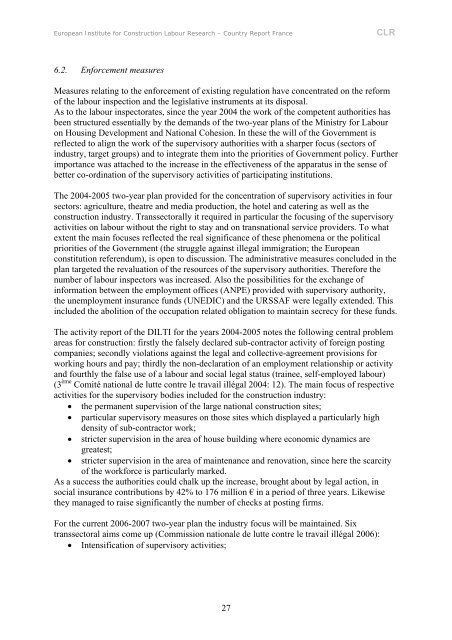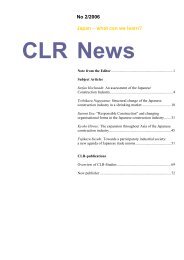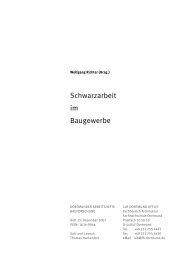Country report France - Construction Labour Research
Country report France - Construction Labour Research
Country report France - Construction Labour Research
You also want an ePaper? Increase the reach of your titles
YUMPU automatically turns print PDFs into web optimized ePapers that Google loves.
European Institute for <strong>Construction</strong> <strong>Labour</strong> <strong>Research</strong> – <strong>Country</strong> Report <strong>France</strong>CLR6.2. Enforcement measuresMeasures relating to the enforcement of existing regulation have concentrated on the reformof the labour inspection and the legislative instruments at its disposal.As to the labour inspectorates, since the year 2004 the work of the competent authorities hasbeen structured essentially by the demands of the two-year plans of the Ministry for <strong>Labour</strong>on Housing Development and National Cohesion. In these the will of the Government isreflected to align the work of the supervisory authorities with a sharper focus (sectors ofindustry, target groups) and to integrate them into the priorities of Government policy. Furtherimportance was attached to the increase in the effectiveness of the apparatus in the sense ofbetter co-ordination of the supervisory activities of participating institutions.The 2004-2005 two-year plan provided for the concentration of supervisory activities in foursectors: agriculture, theatre and media production, the hotel and catering as well as theconstruction industry. Transsectorally it required in particular the focusing of the supervisoryactivities on labour without the right to stay and on transnational service providers. To whatextent the main focuses reflected the real significance of these phenomena or the politicalpriorities of the Government (the struggle against illegal immigration; the Europeanconstitution referendum), is open to discussion. The administrative measures concluded in theplan targeted the revaluation of the resources of the supervisory authorities. Therefore thenumber of labour inspectors was increased. Also the possibilities for the exchange ofinformation between the employment offices (ANPE) provided with supervisory authority,the unemployment insurance funds (UNEDIC) and the URSSAF were legally extended. Thisincluded the abolition of the occupation related obligation to maintain secrecy for these funds.The activity <strong>report</strong> of the DILTI for the years 2004-2005 notes the following central problemareas for construction: firstly the falsely declared sub-contractor activity of foreign postingcompanies; secondly violations against the legal and collective-agreement provisions forworking hours and pay; thirdly the non-declaration of an employment relationship or activityand fourthly the false use of a labour and social legal status (trainee, self-employed labour)(3 ème Comité national de lutte contre le travail illégal 2004: 12). The main focus of respectiveactivities for the supervisory bodies included for the construction industry:• the permanent supervision of the large national construction sites;• particular supervisory measures on those sites which displayed a particularly highdensity of sub-contractor work;• stricter supervision in the area of house building where economic dynamics aregreatest;• stricter supervision in the area of maintenance and renovation, since here the scarcityof the workforce is particularly marked.As a success the authorities could chalk up the increase, brought about by legal action, insocial insurance contributions by 42% to 176 million € in a period of three years. Likewisethey managed to raise significantly the number of checks at posting firms.For the current 2006-2007 two-year plan the industry focus will be maintained. Sixtranssectoral aims come up (Commission nationale de lutte contre le travail illégal 2006):• Intensification of supervisory activities;27









